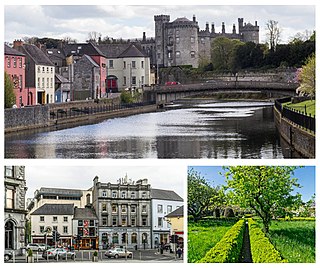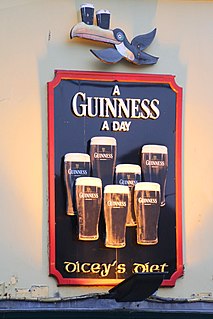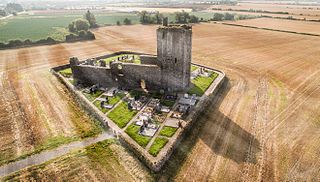
Kilkenny is a city in County Kilkenny, Ireland. It is located in the South-East Region and in the province of Leinster. It is built on both banks of the River Nore. The 2016 census gave the total population of Kilkenny as 26,512.

Smithwick's is an Irish red ale-style beer.

Irish red ale, also known as red ale or Irish ale, is a style of pale ale that is brewed using a moderate amount of kilned malts and roasted barley, giving the beer its red colour. Its strength typically ranges from 3.8% to 4.8% alcohol by volume, although some craft varieties can be as high as 6%.

Kilcrea Friary is a ruined medieval abbey located near Ovens, County Cork, Ireland. Both the friary and Kilcrea Castle, located in ruin to the west, were built by Observant Franciscans in the mid 15th century under the invitation of Cormac Láidir MacCarthy, Lord of Muskerry, as protection from English troops.

Brewing in Ireland has a long history. Production currently stands at over 8 million hectolitres, and approximately half the alcohol consumed is beer.
Lett's Brewery was a beer manufacturer based in Enniscorthy, County Wexford, Ireland. It opened in 1864.

The Buttevant Franciscan Friary is a ruined 13th-century Franciscan friary is situated in the middle of the town of Buttevant, County Cork, Ireland. The Augustinian friary in nearby Ballybeg is often confused with the Buttevant Franciscan Friary in historical documents.

Kilkenny is a nitrogenated Irish cream ale from the makers of Guinness, which originated in Kilkenny, Ireland. The brand is managed and produced by Diageo. It is available in draught, bottles and cans. It is brewed in Ireland. Kilkenny is similar to Smithwick's Draught; however, it has less hop finish, and it has a nitrogenated cream head similar to Guinness. The 'Kilkenny' name was originally used during the 1980s and 1990s to market a stronger version of Smithwick's for the European and Canadian markets due to difficulty in pronunciation of the word 'Smithwick's'. It now refers to a similar yet distinct beer.
The Great Northern Brewery, on the Carrick Road, Dundalk, County Louth, was an Irish brewery. It was home to Harp Lager, and was formerly owned by Diageo. In 2015 the brewery closed, and production of Harp Lager and other products was moved to St. James's Gate Brewery in Dublin. The site has since been bought by John Teeling, and converted for operation as a distillery, the Great Northern Distillery.

Smithwick's Experience Kilkenny was a brewery-turned-brewery-tour located on the "medieval mile" in Kilkenny, Ireland.

Baldongan Church, also called Baldungan Castle, is an ancient ruined church and National Monument near Skerries, County Dublin, Ireland.

Moor Abbey Franciscan friary was founded in the 13th century in County Tipperary, Ireland. It is today a National Monument.

Thomastown Church is a medieval church and National Monument in County Kilkenny, Ireland.

St. Mary's Church is a medieval church and National Monument in Callan, Ireland.

St John's Priory, is a medieval Augustinian priory and National Monument located in Kilkenny City, Ireland. The Lady Chapel of the priory is now used as a parish church of the Church of Ireland.

Carlingford Abbey, also called Carlingford Friary or Carlingford Priory, is a medieval Dominican abbey and National Monument located in Carlingford, County Louth, Ireland.

Ardfert Abbey is a medieval Franciscan friary and National Monument located in County Kerry, Ireland.

Portumna Abbey is a medieval Cistercian friary and National Monument located in Portumna, Ireland.

Donaghcumper Church is a ruined medieval church in Celbridge, Ireland. On the Record of Monuments and Places it bears the code KD011-013.

Askeaton Abbey or Askeaton Friary is a former Franciscan monastery and National Monument located in County Limerick, Ireland.




















